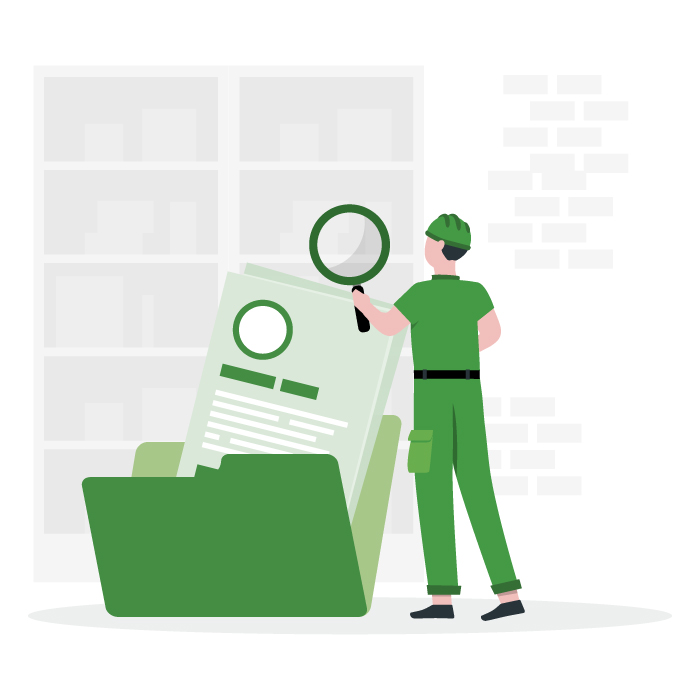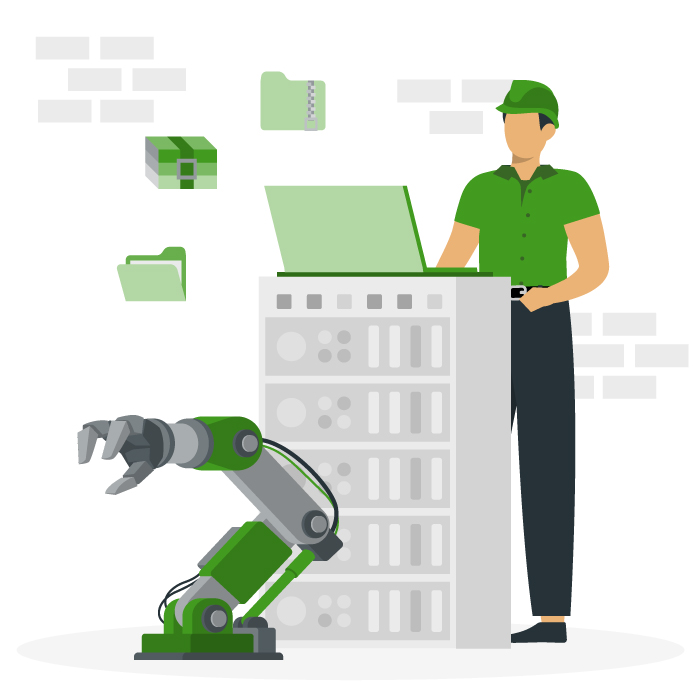Building Maintenance
Everything you ever needed to know about building maintenance.
What is building maintenance?
Building maintenance is the upkeep, repair, and other work performed on a building to keep it safe, presentable, and functional for the people who use it.
A building is similar to a giant machine, with parts that will deteriorate and require updates and maintenance over time. To keep a building in good condition, it must have a well-planned maintenance strategy for inspection, maintenance, and repair.
Table of Contents
- Everything you ever needed to know about building maintenance.
- What is building maintenance?
- Common types of building and facility maintenance
- Building Maintenance Checklist
- Industries that require building maintenance management
- Benefits of building maintenance
- How to improve building maintenance and reduce costs
- Building maintenance jobs
- Certifications and training for building maintenance professionals
- Staying up to date in building maintenance
- The hero of building maintenance
- Related Content
Common types of building and facility maintenance
Building maintenance consists of a wide variety of tasks. Common activities that must be performed regularly include:
- Washing and cleaning different surfaces (bathrooms, floors, windows, handrails, gutters)
- Maintaining and repairing all assets inside the building (HVAC systems, elevators, servers, emergency generators)
- Maintaining and repairing the building itself (doors, carpentry, windows, walls, roof)
- Maintaining property outside and around the building (landscaping, driveways, sidewalks)
Routine
Routine maintenance are activities that must be done on a regular rotation in order to maintain function or appearance of some aspect of your building or ensure inspections are completed to identify the need for more significant work.
Preventive
Preventive maintenance are those activities that are completed proactively in order to prevent or slow wear, tear, and deterioration. They are typically triggered at certain time intervals, or after a certain amount of use has occurred on a particular part or feature of a building.
Corrective
Corrective maintenance activities are those performed to fix, repair, or otherwise restore a building component to functionality. They may be needed in response to typical wear and tear or damage caused by external factors.
Emergency
The need for emergency maintenance may come from any number of sources, but what sets it apart is its high priority level. Emergency maintenance is maintenance work that must be performed as soon as possible in order to restore a core or critical function of the building to return it to useable condition.
Building Maintenance Checklist
Use this helpful template as a starting point for your building maintenance program.
Industries that require building maintenance management
Building owners in any industry must have some form of building or property maintenance program in place.
Businesses, retail, and healthcare
All buildings require maintenance. Any business that has brick-and-mortar facilities must ensure that they have a process in place to maintain the functionality, presentability, and safety of their building. The requirements may vary depending on the use of the building such as in the case of highly regulated industries such as healthcare. But even retail and other businesses have an interest in keeping their buildings in good condition to attract workers and customers.
Residential facilities
When providing homes for individuals and families, safety should be of utmost importance. Sound building maintenance practices will help keep residential facilities safe and attractive to renters and also minimize risk for the property management company.
Government
Governments and municipalities typically take a big-picture approach to building maintenance. Spreading resources across numerous public facilities such as post offices, libraries, and parks helps ensure that all buildings are in good condition with the most efficient use of taxpayer dollars.
Benefits of building maintenance
Safety
A poorly maintained building is an accident waiting to happen. One example is the collapse of the Champlain Towers in South Florida in 2021. The reinforced concrete structural supports were damaged likely due to unaddressed deterioration from exposure to water. When the tower collapsed, 98 people died, 11 were injured, and the resulting property damage came close to $1 billion.
When essential maintenance gets pushed to the back burner, the results can be tragic. With regular building maintenance, you can improve safety at your facility and easily avoid costly or tragic incidents.
Cost savings
Putting off regular building maintenance to cut costs is short-sighted. Planning a budget for regular long-term upkeep is much easier to forecast than the costs of unmanaged deterioration. It also costs much less than emergency repairs. There are many strategies that can help you plan ahead to keep building maintenance costs down. Here are just a few:
- Use a CMMS to track asset lifecycle and get alerts when a machine is approaching the end of its useful life.
- Schedule preventive maintenance tasks and set up systems for accountability so they don’t get overlooked.
- Increase productivity to save money by automating activities such as preventive maintenance scheduling and purchasing workflows.
- Check for lapses in energy efficiency, like drafts or leaks.
- Manage assets and parts inventory to measure usage and identify assets that are costing you in energy and maintenance.
Improved building functionality
Like any machine, without regular maintenance inspection and repair, a building will deteriorate. When systems within your building fail – whether it is a utility or a part of the building’s infrastructure – it becomes less useable.
Regular maintenance provides visibility to emerging issues, allowing for early intervention. It also ensures that components are less likely to break down and cause outages and disruptions.
Compliance
Industry knowledge about best practices for building safety and maintenance evolve over time. Requiring regular maintenance through strict standards helps governments ensure the safety of building occupants.
Regular building maintenance is essential to ensure compliance with ever-changing building and safety codes, as well as state and federal regulations. It is also critical for minimizing liability and legal risk to your organization.
How to improve building maintenance and reduce costs
Here are a few simple ways to start saving big money seeing big improvements in building maintenance.
Automate maintenance work with software
Using CMMS software can help automate work assignments and work order management. By syncing work orders across all your devices and team members, you save valuable time (and therefore, money) that was previously spent on manual communications.
Using a CMMS with a robust mobile CMMS app, means better organization, communication, accountability, and productivity.
Find the right partners
It’s important to interview multiple vendors to find the right fit for your business and budget. Don’t be afraid to negotiate prices with both tenants (like CAM charges) and contractors.
A CMMS solution can also help with vendor management. Many offer the ability to add outside contractors to your list of users so they can receive work orders through the app, allowing you to track the progress of their work.
Reduce energy costs
Another way to save money and get more efficient is by leveraging strategies that reduce energy consumption. Here are a few things to consider to become more energy-efficient:
- Appoint an energy director and form an energy team that is responsible for designing and implementing an energy policy
- Implement a building energy management system (BEMS)
- Prioritize energy efficiency when shopping for new assets and equipment
- Perform routine maintenance to keep assets in peak operating condition
- Use smart and automated building technologies
Building maintenance jobs
Like any other field, building maintenance involves different roles. Depending on their size and resources, different businesses may choose to outsource some of these roles or manage them in-house to have greater control over expenses and strategy.
-
- Janitor: Janitorial services keep the building functional by ensuring a clean and presentable space.
- Maintenance technicians: A maintenance technician’s job is to perform routine maintenance tasks, fix and maintain equipment like air conditioning and electrical systems, deal with simpler issues such as fixing light bulbs and roofing, and more.
- Facility managers: Facility managers coordinate and oversee all facility management and maintenance work and staff. They also manage projects, develop strategies, enforce EHS standards, and more.
- Other outsourced functions: Other activities that require specialized skills or equipment are commonly outsourced such as landscaping, snow removal, or electrical work.
Certifications and training for building maintenance professionals
Ongoing training is important to keep your skills sharp and ensure you’re always in compliance with ever-changing rules and regulations. Some standard certifications/training programs are:
- HVAC Certification: The National Association of Home Builders and the Associated Builders and Contractors offer apprenticeships that help maintenance workers earn HVAC certifications.
- Building Systems Maintenance Certification: This covers plumbing, HVAC systems, water treatment, and efficient energy management. BOMI International awards the certification.
- Building Operator Certification: This includes two levels of maintenance training for building operators. This certification covers HVAC, control point management, electrical distribution, and energy management.
- Certified Maintenance and Reliability Technician: This is an entry-level certification for maintenance professionals. The CMRP assessment test covers both predictive/preventative maintenance and corrective maintenance.
Staying up to date in building maintenance
Joining a trade organization or subscribing to industry news publications can be invaluable ways to stay current and compliant with building maintenance requirements. Here are a few helpful sources of the latest news, information, and best practices in the field.
- International Facilities Management Association: IFMA is the largest association for facility management professionals.
- Association for Facilities Engineering: AFE is a professional organization that provides resources for all professionals working in the “built environment.”
- Facilities Management Institute: The FMI governs the evolving criteria for the facilities management career track. Its mission is to promote and accelerate the development of the facilities management profession across both public and private sectors.
Want to see Limble in action? Get started for free today!
The hero of building maintenance
Being responsible for building maintenance services and everything it entails can be a daunting job. To make your life easier, make sure to use all the tools at your disposal.
There are plenty of resources available to help you stay on top of changes, trends, and responsibilities to keep buildings in tip-top shape. Our pros at Limble can help you make building maintenance easier and more efficient by adding a CMMS. Contact us today or get started for free.


